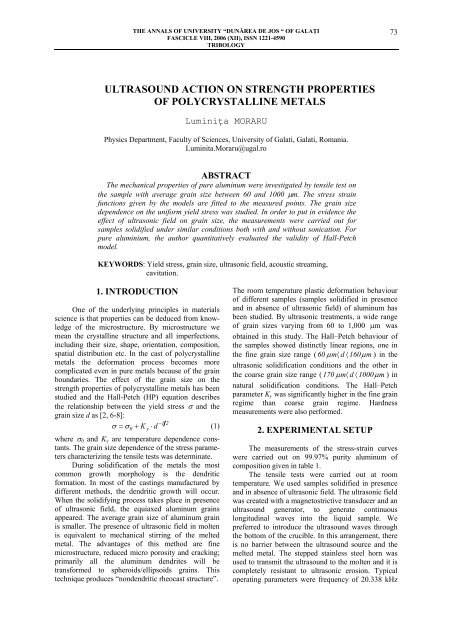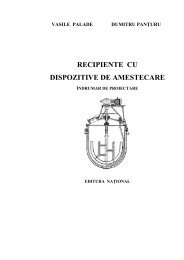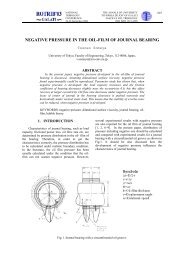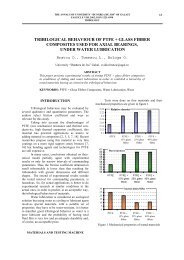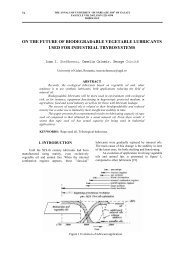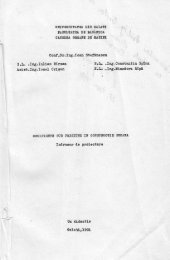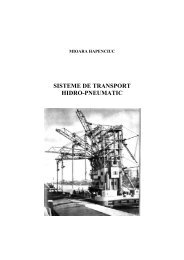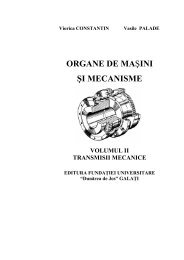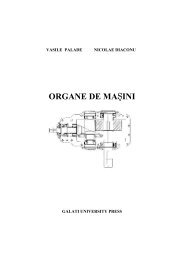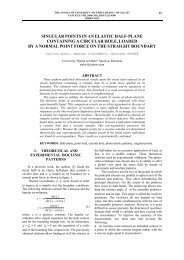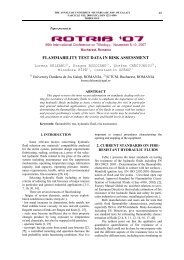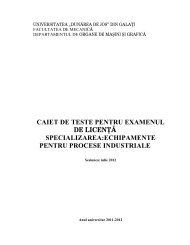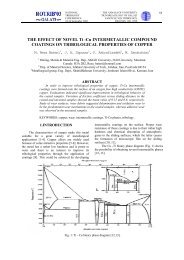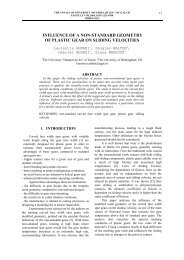ultrasound action on strength properties of polycrystalline metals
ultrasound action on strength properties of polycrystalline metals
ultrasound action on strength properties of polycrystalline metals
Create successful ePaper yourself
Turn your PDF publications into a flip-book with our unique Google optimized e-Paper software.
THE ANNALS OF UNIVERSITY “DUNĂREA DE JOS “ OF GALAŢI<br />
FASCICLE VIII, 2006 (XII), ISSN 1221-4590<br />
TRIBOLOGY<br />
73<br />
ULTRASOUND ACTION ON STRENGTH PROPERTIES<br />
OF POLYCRYSTALLINE METALS<br />
Luminiţa MORARU<br />
Physics Department, Faculty <strong>of</strong> Sciences, University <strong>of</strong> Galati, Galati, Romania.<br />
Luminita.Moraru@ugal.ro<br />
ABSTRACT<br />
The mechanical <strong>properties</strong> <strong>of</strong> pure aluminum were investigated by tensile test <strong>on</strong><br />
the sample with average grain size between 60 and 1000 µm. The stress strain<br />
functi<strong>on</strong>s given by the models are fitted to the measured points. The grain size<br />
dependence <strong>on</strong> the uniform yield stress was studied. In order to put in evidence the<br />
effect <strong>of</strong> ultras<strong>on</strong>ic field <strong>on</strong> grain size, the measurements were carried out for<br />
samples solidified under similar c<strong>on</strong>diti<strong>on</strong>s both with and without s<strong>on</strong>icati<strong>on</strong>. For<br />
pure aluminium, the author quantitatively evaluated the validity <strong>of</strong> Hall-Petch<br />
model.<br />
KEYWORDS: Yield stress, grain size, ultras<strong>on</strong>ic field, acoustic streaming,<br />
cavitati<strong>on</strong>.<br />
1. INTRODUCTION<br />
One <strong>of</strong> the underlying principles in materials<br />
science is that <strong>properties</strong> can be deduced from knowledge<br />
<strong>of</strong> the microstructure. By microstructure we<br />
mean the crystalline structure and all imperfecti<strong>on</strong>s,<br />
including their size, shape, orientati<strong>on</strong>, compositi<strong>on</strong>,<br />
spatial distributi<strong>on</strong> etc. In the cast <strong>of</strong> <strong>polycrystalline</strong><br />
<strong>metals</strong> the deformati<strong>on</strong> process becomes more<br />
complicated even in pure <strong>metals</strong> because <strong>of</strong> the grain<br />
boundaries. The effect <strong>of</strong> the grain size <strong>on</strong> the<br />
<strong>strength</strong> <strong>properties</strong> <strong>of</strong> <strong>polycrystalline</strong> <strong>metals</strong> has been<br />
studied and the Hall-Petch (HP) equati<strong>on</strong> describes<br />
the relati<strong>on</strong>ship between the yield stress σ and the<br />
grain size d as [2, 6-8]:<br />
−12<br />
σ = σ0 + Ky<br />
⋅ d<br />
(1)<br />
where σ 0 and K y are temperature dependence c<strong>on</strong>stants.<br />
The grain size dependence <strong>of</strong> the stress parameters<br />
characterizing the tensile tests was determinate.<br />
During solidificati<strong>on</strong> <strong>of</strong> the <strong>metals</strong> the most<br />
comm<strong>on</strong> growth morphology is the dendritic<br />
formati<strong>on</strong>. In most <strong>of</strong> the castings manufactured by<br />
different methods, the dendritic growth will occur.<br />
When the solidifying process takes place in presence<br />
<strong>of</strong> ultras<strong>on</strong>ic field, the equiaxed aluminum grains<br />
appeared. The average grain size <strong>of</strong> aluminum grain<br />
is smaller. The presence <strong>of</strong> ultras<strong>on</strong>ic field in molten<br />
is equivalent to mechanical stirring <strong>of</strong> the melted<br />
metal. The advantages <strong>of</strong> this method are fine<br />
microstructure, reduced micro porosity and cracking;<br />
primarily all the aluminum dendrites will be<br />
transformed to spheroids/ellipsoids grains. This<br />
technique produces “n<strong>on</strong>dendritic rheocast structure”.<br />
The room temperature plastic deformati<strong>on</strong> behaviour<br />
<strong>of</strong> different samples (samples solidified in presence<br />
and in absence <strong>of</strong> ultras<strong>on</strong>ic field) <strong>of</strong> aluminum has<br />
been studied. By ultras<strong>on</strong>ic treatments, a wide range<br />
<strong>of</strong> grain sizes varying from 60 to 1,000 µ m was<br />
obtained in this study. The Hall–Petch behaviour <strong>of</strong><br />
the samples showed distinctly linear regi<strong>on</strong>s, <strong>on</strong>e in<br />
the fine grain size range ( 60 µ m〈 d 〈 160µ<br />
m ) in the<br />
ultras<strong>on</strong>ic solidificati<strong>on</strong> c<strong>on</strong>diti<strong>on</strong>s and the other in<br />
the coarse grain size range ( 170 µ m〈 d 〈 1000µ<br />
m ) in<br />
natural solidificati<strong>on</strong> c<strong>on</strong>diti<strong>on</strong>s. The Hall–Petch<br />
parameter K y was significantly higher in the fine grain<br />
regime than coarse grain regime. Hardness<br />
measurements were also performed.<br />
2. EXPERIMENTAL SETUP<br />
The measurements <strong>of</strong> the stress-strain curves<br />
were carried out <strong>on</strong> 99.97% purity aluminum <strong>of</strong><br />
compositi<strong>on</strong> given in table 1.<br />
The tensile tests were carried out at room<br />
temperature. We used samples solidified in presence<br />
and in absence <strong>of</strong> ultras<strong>on</strong>ic field. The ultras<strong>on</strong>ic field<br />
was created with a magnetostrictive transducer and an<br />
<str<strong>on</strong>g>ultrasound</str<strong>on</strong>g> generator, to generate c<strong>on</strong>tinuous<br />
l<strong>on</strong>gitudinal waves into the liquid sample. We<br />
preferred to introduce the <str<strong>on</strong>g>ultrasound</str<strong>on</strong>g> waves through<br />
the bottom <strong>of</strong> the crucible. In this arrangement, there<br />
is no barrier between the <str<strong>on</strong>g>ultrasound</str<strong>on</strong>g> source and the<br />
melted metal. The stepped stainless steel horn was<br />
used to transmit the <str<strong>on</strong>g>ultrasound</str<strong>on</strong>g> to the molten and it is<br />
completely resistant to ultras<strong>on</strong>ic erosi<strong>on</strong>. Typical<br />
operating parameters were frequency <strong>of</strong> 20.338 kHz
74<br />
THE ANNALS OF UNIVERSITY “DUNĂREA DE JOS “ OF GALAŢI<br />
FASCICLE VIII, 2006 (XII), ISSN 1221-4590<br />
TRIBOLOGY<br />
and the nominal input power <strong>of</strong> 600 W. The acoustic<br />
power dissipated by ultras<strong>on</strong>ic probe in 1000mldei<strong>on</strong>ized<br />
water at ambient temperature and pressure<br />
as a functi<strong>on</strong> <strong>of</strong> electrical input power was determined<br />
by calorimetry. These data were used to allow<br />
selecti<strong>on</strong> <strong>of</strong> the appropriate input power to give<br />
c<strong>on</strong>stant transmitted power. After the completi<strong>on</strong> <strong>of</strong><br />
measurements, the ultras<strong>on</strong>ic horn was examined<br />
microscopically. No attack <strong>of</strong> the stainless steel by<br />
liquid metal samples was observed in either case, so<br />
there was no evidence <strong>of</strong> c<strong>on</strong>taminati<strong>on</strong> <strong>of</strong> the liquid<br />
metal by alloying.<br />
Table 1. Chemical compositi<strong>on</strong> <strong>of</strong> sample (ppm).<br />
Fe Si Cu Zn<br />
60 60 30 30<br />
The grain size <strong>of</strong> specimens was determined<br />
using the linear intercept method in c<strong>on</strong>juncti<strong>on</strong> with<br />
a logarithmic Gauss distributi<strong>on</strong>.<br />
To make individual hardness measurements for<br />
aluminium, Brinell hardness tests are widely used.<br />
3. RESULTS AND DISCUSSIONS<br />
Figures 1 and 2 show the yield stress as a<br />
functi<strong>on</strong> <strong>of</strong> grain size for samples solidified under<br />
similar c<strong>on</strong>diti<strong>on</strong>s both with and without s<strong>on</strong>icati<strong>on</strong>.<br />
−1 2<br />
A linear relati<strong>on</strong>ship between σ and d can be<br />
established and it shows that HP equati<strong>on</strong> is valid.<br />
The scatter <strong>of</strong> experimental values is high and it can<br />
be explained by the experimental difficulties in the<br />
determinati<strong>on</strong> <strong>of</strong> the yield stress in this very s<strong>of</strong>t<br />
material. Substituting the c<strong>on</strong>stants obtained for the<br />
fitted straight line into eq. (1), we obtained:<br />
−12<br />
σ = 9.095 + 0.714 ⋅ d without <str<strong>on</strong>g>ultrasound</str<strong>on</strong>g>,<br />
−12<br />
σ = 9.620 + 1.166 ⋅ d with <str<strong>on</strong>g>ultrasound</str<strong>on</strong>g>.<br />
The slope <strong>of</strong> the Hall-Petch plots (K y values) is<br />
higher for samples solidified in ultras<strong>on</strong>ic field<br />
presence. This higher value (see figures 1 and 2) it is<br />
expected to be to twinning. However, this remark will<br />
be followed up by further investigati<strong>on</strong>.<br />
The samples solidified in presence and in<br />
absence <strong>of</strong> the ultras<strong>on</strong>ic field present a different<br />
grain size due to various solidificati<strong>on</strong> c<strong>on</strong>diti<strong>on</strong>s.<br />
The samples solidified without <str<strong>on</strong>g>ultrasound</str<strong>on</strong>g>s presence<br />
present the grain size significantly larger (fig. 3).<br />
When the solidifying process takes place in presence<br />
<strong>of</strong> ultras<strong>on</strong>ic field, the equiaxed fine-grained<br />
aluminum appeared.<br />
The average size <strong>of</strong> aluminum grain is smaller.<br />
The grain size was measured <strong>on</strong> transversal secti<strong>on</strong>s<br />
with areas <strong>of</strong> 40 mm 2 after mechanical and<br />
electrochemical polishing in optical microscope<br />
equipped with image analyzer. Investigati<strong>on</strong>s in our<br />
laboratory <strong>on</strong> aluminum revealed superior mechanical<br />
<strong>properties</strong> for samples solidified in ultras<strong>on</strong>ic field.<br />
The mechanical <strong>properties</strong> obtained for the aluminum<br />
are given in table 2. The ultras<strong>on</strong>ic field presence<br />
caused hardness increased unto 28%.<br />
σ ( MPa )<br />
11.5<br />
11.0<br />
10.5<br />
10.0<br />
9.5<br />
9.0<br />
without us<br />
0.8 1.0 1.2 1.4 1.6 1.8 2.0 2.2 2.4<br />
d - 1/2 ( mm - 1/2 )<br />
Fig. 1. The yield stress as a functi<strong>on</strong> <strong>of</strong> grain size<br />
(without <str<strong>on</strong>g>ultrasound</str<strong>on</strong>g>).<br />
σ ( MPa )<br />
14.5<br />
14.0<br />
13.5<br />
13.0<br />
12.5<br />
12.0<br />
with us<br />
2.5 3.0 3.5 4.0<br />
d - 1/2 ( mm - 1/2 )<br />
Fig. 2. The yield stress as a functi<strong>on</strong> <strong>of</strong> grain size<br />
(with <str<strong>on</strong>g>ultrasound</str<strong>on</strong>g>).<br />
a) b)<br />
Fig. 3. Microstructure <strong>of</strong> 99.97%Al;<br />
(a) without <str<strong>on</strong>g>ultrasound</str<strong>on</strong>g> and (b) with <str<strong>on</strong>g>ultrasound</str<strong>on</strong>g>.
THE ANNALS OF UNIVERSITY “DUNĂREA DE JOS “ OF GALAŢI<br />
FASCICLE VIII, 2006 (XII), ISSN 1221-4590<br />
TRIBOLOGY<br />
75<br />
Without<br />
<str<strong>on</strong>g>ultrasound</str<strong>on</strong>g><br />
With<br />
<str<strong>on</strong>g>ultrasound</str<strong>on</strong>g><br />
Table 2. Hardness test values (HB)<br />
1 2 3 4 5<br />
21.8 21.8 22.0 22.2 22.3<br />
28.0 27.9 28.2 28.2 28.0<br />
It is known that grain boundaries could act as<br />
barriers to dislocati<strong>on</strong> moti<strong>on</strong>, but we also viewed a<br />
grain boundary as a sort <strong>of</strong> "film". If the <strong>properties</strong> <strong>of</strong><br />
the grain boundary were known then a more complete<br />
analysis <strong>of</strong> their <strong>strength</strong>ening effect could be made.<br />
Grain boundaries are simply planar defects between<br />
adjacent grains, each grain having different<br />
crystallographic orientati<strong>on</strong>s. Low angle grain<br />
boundaries occur when the miss-orientati<strong>on</strong> <strong>of</strong> the<br />
lattices <strong>of</strong> adjacent grains is less than 15°. These<br />
boundaries can be modeled as an array <strong>of</strong> edge<br />
dislocati<strong>on</strong>s. The structure <strong>of</strong> high angle grain<br />
boundaries is more complex. The other characteristics<br />
<strong>of</strong> grain boundaries are that they tend to attract<br />
impurities. In a sense, this might be thought <strong>of</strong> as a<br />
film which can either <strong>strength</strong>en or weaken a<br />
material. Grain boundary segregati<strong>on</strong> <strong>of</strong> impurities,<br />
however, does not always embrittle a material [9].<br />
Grain boundaries are lattice imperfecti<strong>on</strong>s and<br />
as such increase the free energy <strong>of</strong> the material. There<br />
is a tendency to minimize the c<strong>on</strong>tributi<strong>on</strong> from grain<br />
boundaries and this involves reducing the grain<br />
boundary area to grain volume ratio, something<br />
which happens as the grains grow larger. While other<br />
factors can cause grains to grow, this is essentially the<br />
process involved in normal grain growth (also called<br />
ideal grain growth). N<strong>on</strong>-ideal grain growth occurs<br />
when grain growth is inhibited by the presence <strong>of</strong> a<br />
sec<strong>on</strong>d phase or is restricted by the edges <strong>of</strong> the<br />
specimen. Ultras<strong>on</strong>ic <str<strong>on</strong>g>acti<strong>on</strong></str<strong>on</strong>g>, cold work, pressure,<br />
magnetic fields, etc. also cause grain growth to<br />
deviate from the ideal case.<br />
The effect <strong>of</strong> grain size <strong>on</strong> the hardness<br />
<strong>properties</strong> <strong>of</strong> <strong>polycrystalline</strong> <strong>metals</strong> c<strong>on</strong>sists in<br />
increasing <strong>of</strong> hardness for the sample with finegrained<br />
structure. It is suggested that this morphology<br />
<strong>of</strong> ingot solidified in ultras<strong>on</strong>ic filed results from<br />
increased growth rate and smaller crystallite size. So,<br />
reducing the grain size <strong>of</strong> a <strong>polycrystalline</strong> material is<br />
an effective way <strong>of</strong> increasing its <strong>strength</strong> [4].<br />
Under ultras<strong>on</strong>ic c<strong>on</strong>diti<strong>on</strong>s, the acoustic flow<br />
takes place in the liquid metal. It is clearly<br />
dem<strong>on</strong>strated that the acoustic flows are associated<br />
with the <str<strong>on</strong>g>ultrasound</str<strong>on</strong>g> absorpti<strong>on</strong>, whatever its nature.<br />
However, the absorpti<strong>on</strong> coefficient is quite small for<br />
the liquid <strong>metals</strong>, so the increase in the temperature <strong>of</strong><br />
the melt caused by absorpti<strong>on</strong> process has been<br />
eliminated. In these c<strong>on</strong>diti<strong>on</strong>s, the reas<strong>on</strong> for this<br />
prominent change in solidificati<strong>on</strong> kinetic is assumed<br />
to be large-scale acoustic streaming. Its effect is a<br />
permanent stirring <strong>of</strong> the melt so the effects <strong>of</strong><br />
thermal and mass homogeneity <strong>of</strong> the melt are quite<br />
obvious [3]. The increasing in the intensity <strong>of</strong> fluid<br />
flow can give rise to grain multiplicati<strong>on</strong>, which can<br />
be attributed to the increased effective nucleati<strong>on</strong> rate<br />
caused by the extremely uniform temperature and<br />
compositi<strong>on</strong> fields in the bulk liquid at early stages <strong>of</strong><br />
solidificati<strong>on</strong>. Also, the forced c<strong>on</strong>vecti<strong>on</strong> increases<br />
the growth rate. The solidificati<strong>on</strong> starts by<br />
heterogeneous nucleati<strong>on</strong> at the crucible wall through<br />
the so- called “big-bang” mechanism. Only a fr<str<strong>on</strong>g>acti<strong>on</strong></str<strong>on</strong>g><br />
<strong>of</strong> the nuclei formed at this stage c<strong>on</strong>tributed to the<br />
formati<strong>on</strong> <strong>of</strong> the chilled z<strong>on</strong>e and the majority <strong>of</strong> the<br />
nuclei are transferred into the hotter bulk liquid and<br />
remelted. The final solidified microstructure depends<br />
largely <strong>on</strong> the amount <strong>of</strong> nuclei surviving after the<br />
big-bang nucleati<strong>on</strong>. Under the <str<strong>on</strong>g>ultrasound</str<strong>on</strong>g> <str<strong>on</strong>g>acti<strong>on</strong></str<strong>on</strong>g> both<br />
the temperature and compositi<strong>on</strong> fields <strong>of</strong> the liquid<br />
metal are extremely uniform. The nuclei formed will<br />
survive due to the uniform temperature field,<br />
resulting in an increased effective nucleati<strong>on</strong> rate. In<br />
additi<strong>on</strong>, the intensive stirring may also disperse the<br />
cluster <strong>of</strong> potential nucleati<strong>on</strong> agents, giving rise to an<br />
increased number <strong>of</strong> potential nucleati<strong>on</strong> sites. Also,<br />
under forced c<strong>on</strong>vecti<strong>on</strong>, the nucleati<strong>on</strong> and the<br />
growth at the chilled wall were suppressed, while the<br />
nucleati<strong>on</strong> and growth in the bulk liquid were<br />
enhanced [1].<br />
It has been suggested that the forced c<strong>on</strong>vector<br />
fluid flow induced by <str<strong>on</strong>g>ultrasound</str<strong>on</strong>g> may be sufficient to<br />
break small dendrite arms and distribute them<br />
throughout the melt. If a high energy boundary is<br />
formed in a metal in c<strong>on</strong>tact with its liquid then the<br />
c<strong>on</strong>diti<strong>on</strong> indicates that the grain boundary will be<br />
wetted by the liquid phase, i.e. replaced by a thin<br />
layer <strong>of</strong> liquid and thus the dendrites break appear.<br />
Further these broken dendrites act as nucleants and<br />
grow as globular n<strong>on</strong>dendrite structures. The acoustic<br />
streaming produced the change in possibility that<br />
hydrodynamic force to cause breakage <strong>of</strong> dendritic<br />
arms under the solidificati<strong>on</strong> c<strong>on</strong>diti<strong>on</strong>s. In the same<br />
time, due to supplementary energy c<strong>on</strong>tributi<strong>on</strong>, the<br />
ultras<strong>on</strong>ic field presence hinders the l<strong>on</strong>g-range<br />
ordering processes <strong>of</strong> atoms. At this moment, they act<br />
as nuclei for the growth <strong>of</strong> more particles and the<br />
relatively small dendrite spacing are created.<br />
The possibility that fluid flow could disrupt the<br />
crystal b<strong>on</strong>ding is also c<strong>on</strong>sidered [5]. The shear<br />
forces resulting from natural c<strong>on</strong>vecti<strong>on</strong> flow <strong>of</strong> the<br />
melt are too weak to disrupt the crystal b<strong>on</strong>ding<br />
during solidificati<strong>on</strong>. However under ultras<strong>on</strong>ic field,<br />
these forces are dramatically increasing. The accuracy<br />
<strong>of</strong> s<strong>on</strong>ic measurements is reas<strong>on</strong>able taking into<br />
account the difficulties associated with getting the<br />
<str<strong>on</strong>g>ultrasound</str<strong>on</strong>g> into the melted metal.<br />
The ultras<strong>on</strong>ic field presence into a liquid<br />
causes cavitati<strong>on</strong> phenomen<strong>on</strong> [1]. This imposes a<br />
sinusoidal variati<strong>on</strong> in pressure <strong>on</strong> a steady state<br />
ambient pressure. One new questi<strong>on</strong> <strong>of</strong> this study is<br />
the problem <strong>of</strong> cavitati<strong>on</strong> and its microstreaming<br />
effect. The effect <strong>of</strong> <str<strong>on</strong>g>ultrasound</str<strong>on</strong>g> increases with<br />
increasing power, but not indefinitely since there is an<br />
optimum value bey<strong>on</strong>d which the effect diminishes.
76<br />
THE ANNALS OF UNIVERSITY “DUNĂREA DE JOS “ OF GALAŢI<br />
FASCICLE VIII, 2006 (XII), ISSN 1221-4590<br />
TRIBOLOGY<br />
When 20.338 kHz high-intensity <str<strong>on</strong>g>ultrasound</str<strong>on</strong>g> was<br />
applied to the molten system, a mixing <strong>of</strong> the melted<br />
metal close to the solid-liquid interface and the<br />
crucible wall due to cavitati<strong>on</strong> was produced. Near<br />
the solid surface, cumulative jets can be generated<br />
and the diffusi<strong>on</strong> layer is thinned due to enhanced<br />
mass transport resulting from microstreaming. In our<br />
experiment, these optimum c<strong>on</strong>diti<strong>on</strong>s in cavitati<strong>on</strong><br />
were studied in dei<strong>on</strong>ized water at ambient<br />
temperature. The ultras<strong>on</strong>ic treatment <strong>of</strong> liquid <strong>metals</strong><br />
differed essentially from that <strong>of</strong> aqueous soluti<strong>on</strong>s<br />
and organic liquids. This is due to the different nature<br />
<strong>of</strong> cavitati<strong>on</strong> nuclei and, hence different c<strong>on</strong>diti<strong>on</strong>s<br />
required for the initiati<strong>on</strong> and development <strong>of</strong><br />
acoustic cavitati<strong>on</strong>. Only fine solid particles (mainly<br />
oxides, e.g. Al 2 O 3 in aluminum melt) can act as<br />
cavitati<strong>on</strong> nuclei in metallic melts. At the same time,<br />
because the molten <strong>metals</strong> feature light opacity, the<br />
cavitati<strong>on</strong> cannot be studied directly.<br />
4. CONCLUSION<br />
In the cast <strong>of</strong> <strong>polycrystalline</strong> <strong>metals</strong> the deformati<strong>on</strong><br />
process has been studied related with the grain<br />
size in order to highlight the <strong>strength</strong> <strong>properties</strong> <strong>of</strong><br />
<strong>polycrystalline</strong> <strong>metals</strong> and to study the applicability<br />
<strong>of</strong> the Hall-Petch (HP) equati<strong>on</strong>.<br />
A linear relati<strong>on</strong>ship between σ and d<br />
−1 2<br />
can<br />
be established and it shows that HP equati<strong>on</strong> is valid.<br />
This study was making for samples solidified<br />
under similar c<strong>on</strong>diti<strong>on</strong>s both with and without high<br />
power ultras<strong>on</strong>ic field presence. Our investigati<strong>on</strong>s <strong>on</strong><br />
aluminum revealed superior mechanical <strong>properties</strong> for<br />
samples solidified in ultras<strong>on</strong>ic field.<br />
Studies into the Hall-Petch relati<strong>on</strong>ship show<br />
that the factor K is different in tensi<strong>on</strong> and<br />
compressi<strong>on</strong>. No systematic studies have been d<strong>on</strong>e<br />
<strong>on</strong> the effects <strong>of</strong> solutes <strong>on</strong> the K values and the<br />
difference in tensi<strong>on</strong> and compressi<strong>on</strong>. In future this<br />
represents another aims to investigate.<br />
REFERENCES<br />
1. Abramov O.V., 1993, Ultrasound in liquid and solid <strong>metals</strong>,<br />
Russian Academy <strong>of</strong> Sciences, Moscow, (in English).<br />
2. Kassner M.E., Li X., 1991, The Mechanical Properties <strong>of</strong> in-<br />
Situ Composites, Scripta Metall. And Mater, vol. 25, pp. 2833-<br />
2860.<br />
3. Moraru L. 2005, The effect <strong>of</strong> fluid flow <strong>on</strong> solidificati<strong>on</strong> <strong>of</strong><br />
light metal alloy, Trans<str<strong>on</strong>g>acti<strong>on</strong></str<strong>on</strong>g> <strong>of</strong> the University <strong>of</strong> Kosice, vol. 5,<br />
pp. 70-75.<br />
4. Moraru L., 2003, Mechanical <strong>properties</strong> <strong>of</strong> 99,97% Al related to<br />
grain size and ultras<strong>on</strong>ic influence, U.P.B. Sci Bull., Seria B, vol. 1,<br />
No 65, pp. 59-65.<br />
5. Moraru L., Tudose C., 2004, Analytic model <strong>of</strong> b<strong>on</strong>ding forces<br />
in liquid <strong>metals</strong> and <str<strong>on</strong>g>ultrasound</str<strong>on</strong>g> influence, Proc. <strong>of</strong> 2 nd Int. C<strong>on</strong>f.<br />
Romanian Acoustical Society, Impuls Publishing House, Bucureşti,<br />
pp. 75-80.<br />
6. Petch N.J., 1953, The cleavage <strong>strength</strong> <strong>of</strong> polycrystals, J. Ir<strong>on</strong><br />
and Steel Inst., vol. 147, pp. 25-28.<br />
7. Singh K.K., Sangal S., Murty G.S., 2002, Hall–Petch<br />
behaviour <strong>of</strong> 316L austenitic stainless steel at room temperature,<br />
Materials Science and Technolog,y , vol. 18 (2), pp. 165-172(8)<br />
8. Singh K.K., 2004, Strain hardening behaviour <strong>of</strong> 316L<br />
austenitic stainless steel, Materials Science and Technolog,y , vol.<br />
20 (9), pp. 1134-1142(9).<br />
9. S<strong>on</strong>g H.W., Guo S.R., Hu Z.Q., 1999, A coherent polycrystal<br />
model for the inverse Hall-Petch relati<strong>on</strong> in nanocrystalline<br />
materials, Nanostructured Mater., vol. 11(2), pp. 203-210.


